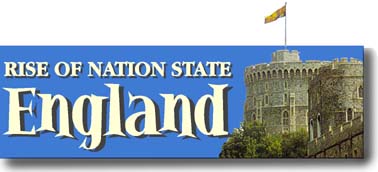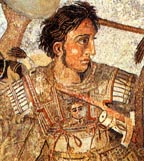|
|


Mr. Sedivy's
History Classes:









More Features:


 

 

|
|
Highlands Ranch High School - Mr. Sedivy
Highlands Ranch, Colorado
Rise of Nation State England
- The Celts -
Threat of the Celts, Celtic Battles and Conquests
Macedonia / Alexander the Great
In 335 BC, Alexander the Great had a meeting with three Celtic envoys
in Macedonia. Knowing the Celts valor, Alexander asked what the Celts
feared above all else. "The sky may fall on their head," was their
reply. "Boastful chaps," muttered Alexander. (He expected that they
would fear him the most.)

Alexander the Great
"People of great stature
and haughty disposition,"
wrote the Greek historian, Arrian.
Celt Land Conquest
A Swiss Celtic tribe decided to go southwest seeking broader lands.
They set about it in great fashion. The tribe produced surplus crops
for two years, and made hundreds of wagons for their journey. They
burned 400 villages to strengthen their resolve not look back.
The Mediterranean / Caesar
The Romans were concerned that the Celts would put pressure on the
Mediterranean and felt threatened. Caesar also saw this as a perfect
opportunity for an easy victory because the Celts had no fortifications
to protect themselves. Caesar savagely massacred them. A census on
the eve of their departure tallied 368,000 - Caesar reported that
258,000 of the Celts were killed. Following this, Caesar fought some
30 battles, took more than 800 towns, and killed, by his own count,
1,192,000 men, women, and children.
Alesia / Celt Chief Vercingetorix
The year, 52 BC, was a crucial year. Gaul and the Celts had finally
united and they rallied behind a young chief Vercingetorix. His strategy
was not haphazard tribal raiding. They would fight as a team. They
would burn cities and farms if they lost, so that the Romans could
not live off the land. He used guerrilla warfare to cut off Caesar's
supplies and reinforcements.
The initial successes were followed by disasters. He
withdrew 80,000 men to Alesia "rocky hill" in Celtic. Alesia was a
fortified city. Vercingetorix didn't have to wait long for Caesar
to follow. Before the Gauls unbelieving eyes, the Roman Legions ringed
the fortifications 9.5 miles around.
Vercingetorix hurled his elite horseman at the entrenching
Romans. Just before the ring closed, he slipped his cavalry out to
summon relief from tribes far and wide. Caesar's position now grew
critical. While starving out the fortress in front, Vercingetorix
was now vulnerable from the rear. Again he told the boys to start
digging, this time an outside ring 14 miles around! Between the two
perimeters, Caesar had 40,000 men and was ready to fight in two directions
simultaneously.
(A model of those fearsome siege works is shown in the
National Museum of Antiquities at St. Germain en Laye. "Minefields"
sown with log-anchored iron hooks to rip and break legs, brush-covered
"tank traps" with fire-hardened stakes embedded to disembowel man
and mount, the "barbed-wire thicket" of sharpened forked loglegionaries
called "tomstones." Then formidable double ditches. Finally, the bristling
earth-and-log ramparts topped with palisades and backed by redoubts
towers.)
Relief forces finally arrive - more than a quarter of
a million Celts from at least two score tribes. Starving Celts, trying
to break out of Alesia, die in the traps, on the inner walls. Caesar,
in his red cape, swiftly moves reinforcements to stem the breach.
Vercingetorix emerges alone from the gates of Alesia. He dismounts,
flings down his weapons, and sits in silent submission at the feet
of his conqueror. The Romans found settlements of timber, and made
them stone. Gallic magistrates adopted the toga and the name Julius.
Roman Gaul remained Celtic Gaul in disguise.
Celtic Christianity
The Celts became Roman Christians. Old habits are hard to break -
like the Celtic warrior who boasted of killing an enemy everyday of
the week. On becoming Christian, so as not to profane the Sabbath,
he killed two on Saturday.
Biggest Nonevent in Irish History
The biggest nonevent in Irish history is that "the Romans never got
here."
"Nor the Saxons. So we remained Celtic. We kept our
peculiar patterns of society and customs, our Celtic approach to life.
'Ireland,' out of disunity, saved us," added Mr. Sedivy's history-savvy
traveling companion, Etienne, on a recent trip to UK. Etienne continued,
"When the Vikings stormed ashore, there was no central government
to conquer, and no towns. So the Vikings built their own Dublin, Cork,
and Limerick, and lived apart." Etienne added, "Then the Anglo-Normans
came. They built castles but couldn't conquer the country either."

Wild Irishmen, c. 1187. An Irishman is shown standing
on the back of another
and hacking him with an axe, the symbol of unrestrained violence.
Mr. Sedivy's Excellent Celtic Trivia
Even in the grave, the Irish never stopped fighting. Kings would ask
to be buried upright, sword or javelin in hand, facing the foe. Connaugh
men were invincible, driving out the men of Ulster, until the invaders
dug up the old king and broke the spell by re-interring him head down.
Modern Celts can be very ascetic. They like their pilgrimages harsh,
such as climbing Croagh Patrick the last Sunday in July on bare, bleeding
feet.

The marriage of an Irish king to his country in Ulster,
c. 1187.
A horse was boiled in a bath, then the king sat in the bath surrounded
by his people. They all ate horse meat and drank the water. This symbolized
the unity of king and people.
Back to top of page
Mr. Sedivy's Lecture Notes
& Historical Info
The Celts
| Gallic He-Men | Celtic
Culture, Trade, Religion, Women |
| Threat of the Celts - Celtic Battles and
Conquests |
- Rise of Nation State England -
| Roman Conquest of Britain | Christianity
in Britain |
| Customs: Thanes, Churls, Thralls, Wergeld,
Folk-Moot |
| Dark Ages: Alfred the Great, Edward the
Elder, Athelstan |
| The Return of the Vikings |
| Kings of Britain: Aethelred, Cnut, Edward
the Confessor |
| Bayeaux Tapestry, William the Conqueror,
Edward the Confessor, Harold Godwinson, Harold II |
| The Crusades: Richard Lion Heart, Pope
Urban |
| King John, Innocent III, Archbishop Stephen
Langton |
| Magna Carta / First Parliament |
Wales and Scotland
| Wales: Edward I, Llewellyn, Snowdonia
|
| Scotland: Alexander III, John Balliol,
William Wallace, Robert Bruce, King Edward II |
The 100 Years War
| Edward III, Longbows at Crecy, Edward IV,
Black Prince |
| Henry V, King Charles VI, Battle at Calais,
Treaty of Troyes |
More Information
| Other Kings of the Dark and Middle Ages:
William II, Henry I, Henry II |
| The
British Monarchy's Peerage: Dukes, Viscounts,
Marquess, Earls, Baronets, and Barons |
Class Activities
Roman Conquest Comparison
Battle of Agincourt
Related Information
Mr. Sedivy's World History - The Middle
Ages
The Complete Bayeux Tapestry
Roman Catholic Church in the Middle Ages
/ Crusades
The Hundred Years War
King Henry VIII
The Interesting
Life of Elizabeth I
The Stuarts - James I, Charles I, Charles
II, James II
Oliver Cromwell
|
|
|



![]() 9375 South Cresthill Lane
9375 South Cresthill Lane ![]() Highlands Ranch, Colorado 80126
Highlands Ranch, Colorado 80126 ![]() 303-471-7000
303-471-7000



